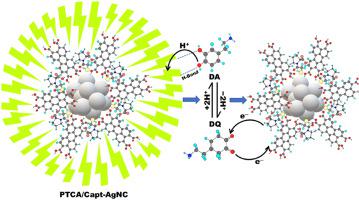当前位置:
X-MOL 学术
›
Mater. Chem. Phys.
›
论文详情
Our official English website, www.x-mol.net, welcomes your
feedback! (Note: you will need to create a separate account there.)
Highly Fluorescent Water-Soluble PTCA Incorporated Silver Nano-cluster for Sensing of Dopamine
Materials Chemistry and Physics ( IF 4.3 ) Pub Date : 2021-02-01 , DOI: 10.1016/j.matchemphys.2020.124086 Tapas Goswami , Amarnath Bheemaraju , Aditya Kataria , Amit Nag , Kaja Sravani , Soni Mishra , Abhishek K. Mishra
Materials Chemistry and Physics ( IF 4.3 ) Pub Date : 2021-02-01 , DOI: 10.1016/j.matchemphys.2020.124086 Tapas Goswami , Amarnath Bheemaraju , Aditya Kataria , Amit Nag , Kaja Sravani , Soni Mishra , Abhishek K. Mishra

|
Abstract In the present work, we designed a novel nanocluster (PTCA/Capt-AgNC) with a remarkably enhanced fluorescence, photostability and water solubility. This green fluorescent nanocluster with dimension of ∼ 2-4 nm was characterized by UV-Vis, Fourier transformed infrared, Raman, photoluminescence (PL) spectroscopies; X-ray diffraction (XRD), high resolution transmission electron microscopy and selected area electron diffraction techniques. It was observed that the incorporation of a tiny amount of 3,4,9,10-perylene tetracarboxylic acid (PTCA) into captopril (Capt) protected silver nanocluster (Capt-AgNCs) resulted in the increase of PLQY by several orders of magnitude compared to PTCA and Capt-AgNCs. The PL studies indicated that the material has high photoluminescence quantum yield (PLQY ∼ 0.25) in comparison to the previously reported Capt-AgNCs. Fluorescence intensity of PTCA/Capt-AgNCs was quenched upon addition of various concentrations of dopamine. Selectivity in fluorescence quenching was evaluated with structurally similar bio-molecules such as L-cysteine and urea. Time resolved fluorescence spectroscopy revealed that the average fluorescence lifetime of the nanocluster was reduced strikingly upon addition of dopamine in comparison to that with L-cysteine and urea which clearly indicated the selectivity and sensitivity. Density functional theory calculations were performed to investigate the PL enhancement and quenching mechanisms. We believe that strategy reported in the present study could be adopted for designing highly efficient biosensors.
中文翻译:

用于感知多巴胺的高荧光水溶性 PTCA 银纳米团簇
摘要 在目前的工作中,我们设计了一种具有显着增强的荧光、光稳定性和水溶性的新型纳米团簇 (PTCA/Capt-AgNC)。这种尺寸约为 2-4 nm 的绿色荧光纳米团簇通过 UV-Vis、傅里叶变换红外、拉曼、光致发光 (PL) 光谱表征;X 射线衍射 (XRD)、高分辨率透射电子显微镜和选区电子衍射技术。观察到将少量的 3,4,9,10-苝四甲酸 (PTCA) 掺入到卡托普利 (Capt) 保护的银纳米簇 (Capt-AgNCs) 中,导致 PLQY 增加了几个数量级。 PTCA 和 Capt-AgNC。PL研究表明该材料具有高光致发光量子产率(PLQY ∼ 0. 25) 与之前报道的 Capt-AgNCs 相比。添加不同浓度的多巴胺后,PTCA/Capt-AgNCs 的荧光强度被淬灭。用结构相似的生物分子(如 L-半胱氨酸和尿素)评估荧光猝灭的选择性。时间分辨荧光光谱显示,与 L-半胱氨酸和尿素相比,添加多巴胺后纳米团簇的平均荧光寿命显着降低,这清楚地表明了选择性和灵敏度。进行密度泛函理论计算以研究 PL 增强和淬灭机制。我们相信本研究中报告的策略可用于设计高效的生物传感器。添加不同浓度的多巴胺后,PTCA/Capt-AgNCs 的荧光强度被淬灭。用结构相似的生物分子(如 L-半胱氨酸和尿素)评估荧光猝灭的选择性。时间分辨荧光光谱显示,与 L-半胱氨酸和尿素相比,添加多巴胺后纳米团簇的平均荧光寿命显着降低,这清楚地表明了选择性和灵敏度。进行密度泛函理论计算以研究 PL 增强和淬灭机制。我们相信本研究中报告的策略可用于设计高效的生物传感器。添加不同浓度的多巴胺后,PTCA/Capt-AgNCs 的荧光强度被淬灭。用结构相似的生物分子(如 L-半胱氨酸和尿素)评估荧光猝灭的选择性。时间分辨荧光光谱显示,与 L-半胱氨酸和尿素相比,添加多巴胺后纳米团簇的平均荧光寿命显着降低,这清楚地表明了选择性和灵敏度。进行密度泛函理论计算以研究 PL 增强和淬灭机制。我们相信本研究中报告的策略可用于设计高效的生物传感器。用结构相似的生物分子(如 L-半胱氨酸和尿素)评估荧光猝灭的选择性。时间分辨荧光光谱显示,与 L-半胱氨酸和尿素相比,添加多巴胺后纳米团簇的平均荧光寿命显着降低,这清楚地表明了选择性和灵敏度。进行密度泛函理论计算以研究 PL 增强和淬灭机制。我们相信本研究中报告的策略可用于设计高效的生物传感器。用结构相似的生物分子(如 L-半胱氨酸和尿素)评估荧光猝灭的选择性。时间分辨荧光光谱显示,与 L-半胱氨酸和尿素相比,添加多巴胺后纳米团簇的平均荧光寿命显着降低,这清楚地表明了选择性和灵敏度。进行密度泛函理论计算以研究 PL 增强和淬灭机制。我们相信本研究中报告的策略可用于设计高效的生物传感器。时间分辨荧光光谱显示,与 L-半胱氨酸和尿素相比,添加多巴胺后纳米团簇的平均荧光寿命显着降低,这清楚地表明了选择性和灵敏度。进行密度泛函理论计算以研究 PL 增强和淬灭机制。我们相信本研究中报告的策略可用于设计高效的生物传感器。时间分辨荧光光谱显示,与 L-半胱氨酸和尿素相比,添加多巴胺后纳米团簇的平均荧光寿命显着降低,这清楚地表明了选择性和灵敏度。进行密度泛函理论计算以研究 PL 增强和淬灭机制。我们相信本研究中报告的策略可用于设计高效的生物传感器。
更新日期:2021-02-01
中文翻译:

用于感知多巴胺的高荧光水溶性 PTCA 银纳米团簇
摘要 在目前的工作中,我们设计了一种具有显着增强的荧光、光稳定性和水溶性的新型纳米团簇 (PTCA/Capt-AgNC)。这种尺寸约为 2-4 nm 的绿色荧光纳米团簇通过 UV-Vis、傅里叶变换红外、拉曼、光致发光 (PL) 光谱表征;X 射线衍射 (XRD)、高分辨率透射电子显微镜和选区电子衍射技术。观察到将少量的 3,4,9,10-苝四甲酸 (PTCA) 掺入到卡托普利 (Capt) 保护的银纳米簇 (Capt-AgNCs) 中,导致 PLQY 增加了几个数量级。 PTCA 和 Capt-AgNC。PL研究表明该材料具有高光致发光量子产率(PLQY ∼ 0. 25) 与之前报道的 Capt-AgNCs 相比。添加不同浓度的多巴胺后,PTCA/Capt-AgNCs 的荧光强度被淬灭。用结构相似的生物分子(如 L-半胱氨酸和尿素)评估荧光猝灭的选择性。时间分辨荧光光谱显示,与 L-半胱氨酸和尿素相比,添加多巴胺后纳米团簇的平均荧光寿命显着降低,这清楚地表明了选择性和灵敏度。进行密度泛函理论计算以研究 PL 增强和淬灭机制。我们相信本研究中报告的策略可用于设计高效的生物传感器。添加不同浓度的多巴胺后,PTCA/Capt-AgNCs 的荧光强度被淬灭。用结构相似的生物分子(如 L-半胱氨酸和尿素)评估荧光猝灭的选择性。时间分辨荧光光谱显示,与 L-半胱氨酸和尿素相比,添加多巴胺后纳米团簇的平均荧光寿命显着降低,这清楚地表明了选择性和灵敏度。进行密度泛函理论计算以研究 PL 增强和淬灭机制。我们相信本研究中报告的策略可用于设计高效的生物传感器。添加不同浓度的多巴胺后,PTCA/Capt-AgNCs 的荧光强度被淬灭。用结构相似的生物分子(如 L-半胱氨酸和尿素)评估荧光猝灭的选择性。时间分辨荧光光谱显示,与 L-半胱氨酸和尿素相比,添加多巴胺后纳米团簇的平均荧光寿命显着降低,这清楚地表明了选择性和灵敏度。进行密度泛函理论计算以研究 PL 增强和淬灭机制。我们相信本研究中报告的策略可用于设计高效的生物传感器。用结构相似的生物分子(如 L-半胱氨酸和尿素)评估荧光猝灭的选择性。时间分辨荧光光谱显示,与 L-半胱氨酸和尿素相比,添加多巴胺后纳米团簇的平均荧光寿命显着降低,这清楚地表明了选择性和灵敏度。进行密度泛函理论计算以研究 PL 增强和淬灭机制。我们相信本研究中报告的策略可用于设计高效的生物传感器。用结构相似的生物分子(如 L-半胱氨酸和尿素)评估荧光猝灭的选择性。时间分辨荧光光谱显示,与 L-半胱氨酸和尿素相比,添加多巴胺后纳米团簇的平均荧光寿命显着降低,这清楚地表明了选择性和灵敏度。进行密度泛函理论计算以研究 PL 增强和淬灭机制。我们相信本研究中报告的策略可用于设计高效的生物传感器。时间分辨荧光光谱显示,与 L-半胱氨酸和尿素相比,添加多巴胺后纳米团簇的平均荧光寿命显着降低,这清楚地表明了选择性和灵敏度。进行密度泛函理论计算以研究 PL 增强和淬灭机制。我们相信本研究中报告的策略可用于设计高效的生物传感器。时间分辨荧光光谱显示,与 L-半胱氨酸和尿素相比,添加多巴胺后纳米团簇的平均荧光寿命显着降低,这清楚地表明了选择性和灵敏度。进行密度泛函理论计算以研究 PL 增强和淬灭机制。我们相信本研究中报告的策略可用于设计高效的生物传感器。











































 京公网安备 11010802027423号
京公网安备 11010802027423号